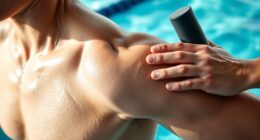To start a 4-week beginner swim workout plan, focus on building comfort in the water, gradually increasing your endurance, and practicing proper techniques. Begin each session with warm-up exercises, then alternate between easy laps, drills, and short rest periods. Keep safety precautions in mind, use your gear correctly, and stay motivated by setting small goals. Stick with this routine, and you’ll gradually see your confidence grow—there’s more to discover as you progress.
Key Takeaways
- Create a gradual 4-week plan focusing on building endurance, technique, and confidence with varied swim drills.
- Incorporate warm-up, main sets, and cool-down phases for balanced workouts each week.
- Start with easy-paced laps and progressively increase distance and intensity over four weeks.
- Include safety checks, proper gear, and rest intervals in each session to promote safety and recovery.
- Track progress weekly, adjusting workouts to match skill improvements and comfort levels.

Starting a swim workout plan as a beginner can be both exciting and intimidating, but with a clear and simple routine, you’ll build confidence and improve your skills quickly. The first step is to guarantee you have the right swimming gear. Invest in a well-fitting swimsuit, goggles, and a swim cap. These items might seem small, but they play a significant role in your comfort and performance. Good goggles help you see clearly underwater, making it easier to focus on your technique, while a snug swimsuit reduces drag and allows free movement. A swim cap protects your hair and keeps water out of your face, especially if you have longer hair. Having the proper gear sets a solid foundation for your workouts and keeps you motivated.
Having the right gear builds confidence and sets a strong foundation for your swimming journey.
As a beginner, understanding pool safety is vital. Always check that the pool environment is safe, clean, and supervised by lifeguards. Familiarize yourself with the pool rules, like no running on the deck or diving in shallow areas. Before you start swimming, do a quick warm-up outside the pool to loosen your muscles. When you get in, start slow and stay aware of your surroundings. If you’re feeling tired or uncomfortable, don’t push yourself too hard—rest is part of a safe workout. Keep an eye on your breathing and maintain a relaxed approach to avoid fatigue or cramps. Remember, never swim alone, especially in unfamiliar pools. Having a buddy or informing someone of your workout plan adds an extra layer of safety.
Throughout your routine, prioritize pool safety by avoiding distractions like using your phone or talking on the phone while in the water. Stick to the designated swimming areas, and if you’re practicing near the edge, be cautious of slips or falls. Respect the pool staff and follow their guidance. They’re there to guarantee everyone’s safety, and paying attention to their instructions minimizes accidents. Also, stay hydrated and take breaks as needed. If your pool has safety equipment like life rings or poles, familiarize yourself with their locations. This awareness not only keeps you safe but also boosts your confidence as you become more comfortable in the water.
Getting your swimming gear ready and understanding pool safety might seem straightforward, but they’re essential steps in creating a positive, safe experience. When you combine the right equipment with safety awareness, you set yourself up for success. You’ll find that with each swim, your confidence grows, and you’ll enjoy the process of improving your skills. Stick to these basics in your first week, and you’ll be surprised at how quickly you gain comfort and proficiency in the water. Your journey into swimming begins with these small, important steps—trust the process, stay safe, and enjoy each splash. Additionally, incorporating high-quality equipment can significantly enhance your comfort and overall experience in the water.
Frequently Asked Questions
What Equipment Do I Need for Beginner Swim Workouts?
For beginner swim workouts, you’ll need basic swimming gear and beginner accessories. Essential items include goggles to see clearly underwater, a swim cap to keep hair out of your face, and a comfortable swimsuit. Consider using kickboards or pull buoys to help build strength and improve technique. These accessories make your swimming experience easier and more effective, ensuring you stay comfortable and motivated as you learn.
How Can I Prevent Common Swimming Injuries?
Don’t put all your eggs in one basket—vary your swimming stroke techniques to prevent overuse injuries. Focus on proper form, listen to your body, and don’t push through pain. Incorporate injury recovery strategies like rest and gentle stretching. Warm up before each session and cool down afterward. Staying mindful of technique and recovery helps you avoid common swimming injuries and keeps your progress steady.
Should I Warm up Before Each Swim Session?
Yes, you should warm up before each swim session. Doing warm-up routines helps prepare your muscles and reduces the risk of injury. Incorporate stretching exercises to loosen up your shoulders, arms, and legs, and do light swimming or dynamic movements to increase blood flow. This way, you’ll improve your performance, stay injury-free, and enjoy your swim more. Always take a few minutes to properly warm up before diving in.
How Do I Improve My Breathing Technique?
Breathe better by balancing breath control drills with breathing exercises. Focus on slow, steady inhales and exhales to build a strong, sustainable rhythm. Practice breath control drills like exhaling underwater and inhaling through your mouth, feeling the flow and flux of your breathing. By consistently combining these techniques, you’ll boost your breathing, improve your stamina, and sync your strokes seamlessly with your breath, making every swim smoother and more satisfying.
What Should I Eat Before and After Swimming?
Before swimming, focus on light, easily digestible nutrition like a banana or yogurt, and stay hydrated with water to boost your energy. After your session, replenish with a balanced meal rich in protein and carbs, such as grilled chicken with rice, and continue hydration with water or electrolyte drinks. These nutrition tips and hydration strategies help optimize recovery, boost stamina, and keep you energized for your next swim.
Conclusion
So, after four weeks of splashing around, you’re basically a fish now—who knew? Just remember, all those laps and drills might make you feel like a pro, but don’t get too big of a head. Keep practicing, enjoy the water, and maybe, just maybe, you’ll impress someone at the pool. Or at least not sink on your next swim. Either way, you’ve earned a break—your swimming journey’s just getting started!










